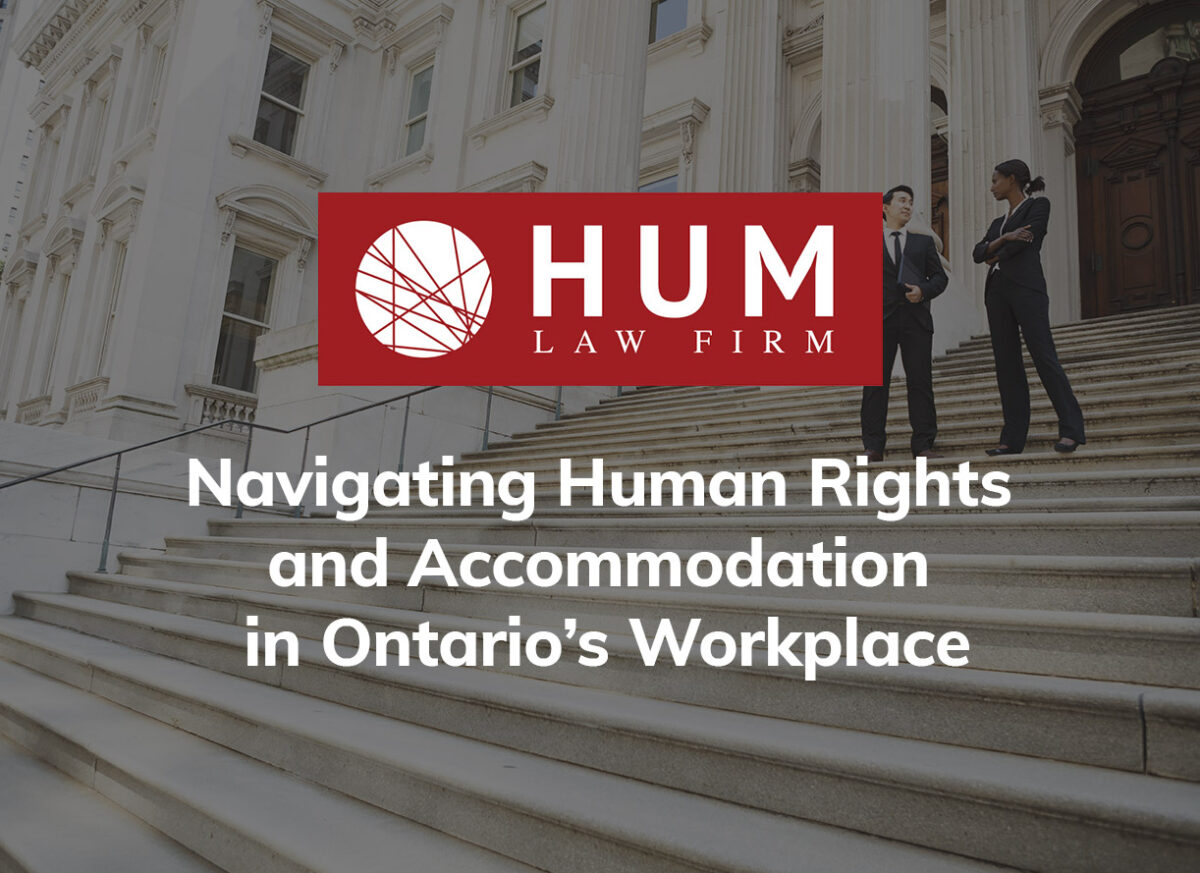Employees are entitled to a workplace free from discrimination and harassment, and employers have a duty to accommodate. In Ontario, specific legislation is in place to protect employees and guide employers on adequately managing their business. Failure to comply with the existing legislation could be costly.
Understanding Human Rights Legislation in Ontario.
Ontario employers are governed by Ontario’s Human Rights Code (“Code”), which prohibits discrimination based on protected grounds in specific social areas, including employment. The other social areas are housing, services, unions and vocational associations and contracts. There are 17 protected grounds: citizenship, race, place of origin, ethnic origin, colour, ancestry, disability, age, creed, sex/pregnancy, family status, marital status, sexual orientation, gender identity, gender expression, and record of offences. Employers must familiarize themselves with these protected grounds to prevent breaches of their employees’ human rights.
Accommodation: A Central Obligation
The Code imposes a crucial responsibility on employers: the duty to accommodate. This mandate compels employers to make reasonable adjustments or arrangements, up to the point of undue hardship, to meet employees’ needs arising from protected grounds. For example, if an employee has a disability and requests accommodation, employers have an obligation to provide suitable accommodations, such as modifying workstations, providing additional break time, or altering work arrangements.
While employers have a duty to accommodate, employees must also play their role in the accommodation process. Firstly, employees should inform their employer of their need for accommodation. This proactive step ensures that the employer is aware of the need for accommodation and can take appropriate action. When an employee’s need for accommodation is evident, the employer should also proactively inquire whether accommodation is required and act accordingly.
Secondly, employees are expected to work collaboratively with the employer and act reasonably to come to an accommodation arrangement. This means engaging in a constructive dialogue with the employer, providing relevant information about their needs, and being open to discussing potential solutions. Collaboration between both parties is essential to finding accommodation solutions that respect the employee’s human rights while also considering the practical constraints of the workplace. Acting reasonably and in good faith during this process is an obligation and a critical factor in reaching a successful accommodation arrangement that benefits both the employee and the employer.
Undue hardship is a high bar to meet, as some degree of hardship is acceptable. The Code prescribes only three considerations when assessing whether an accommodation would cause undue hardship: cost, outside funding sources (if any), and health and safety requirements (if any). No other considerations can be appropriately considered.
The Cost of Non-Compliance
Employers who fail to meet their obligations regarding human rights and accommodation can face severe consequences, including:
Legal Costs: Employees who believe their human rights have been violated can file complaints with the Human Rights Tribunal of Ontario or a court. If a complaint is substantiated, the employer may be ordered to compensate the affected employee. Defending against human rights complaints and legal actions can be costly, including legal fees, settlements, and potential fines. For example, in Giang v. DBG Canada Limited, 2021 HRTO 97, the Human Rights Tribunal of Ontario found the employer discriminated against the employee, as the employer failed to accommodate the employee’s disability (a heart condition that required an implantable defibrillator) and terminated his employment when he refused to work in areas with high voltage machinery that, in the employee’s opinion, could interfere with his device. As a result, the employer had to pay the employee $20,000 as monetary compensation for injury to her dignity, feelings, and self-respect in addition to the loss of income, $39,697.12, the employee claimed for over a year.
Reputation Damage: News of a human rights violation can tarnish an employer’s reputation, making it challenging to attract top talent and maintain a positive public image.
Productivity Loss: Workplace conflicts resulting from human rights violations can decrease productivity, as employees may feel demoralized and disengaged.
Common Pitfalls
(1) The Code goes beyond the ESA:
Employers must understand the nuanced interaction between the Code and Ontario’s Employment Standards Act, 2000 (“ESA”). While the ESA sets minimum employment standards, compliance with these minimum standards does not guarantee Code compliance. A prime example is sick leave entitlements. While the ESA prescribes a minimum of three sick days, the Code extends additional safeguards.
The Code obliges employers to accommodate employees with health issues to the point of undue hardship. This means that employees requiring more than the mandated three sick days due to a disability or health condition should likely be granted additional sick leave as a reasonable accommodation. Neglecting this responsibility can constitute discrimination based on disability, violating the Code.
Employers must be prepared to exceed the ESA’s minimum requirements when accommodating employees. Employers must remain vigilant regarding their obligations under the ESA and the Code to foster a fair and inclusive work environment.
(2) Apparent Neutral Standards with Discriminatory Effects:
Employers often establish seemingly impartial standards or policies without any intent to discriminate. However, these standards can unintentionally produce adverse discriminatory effects. For example, instituting a physical requirement for a job without considering actual job duties may disproportionately affect individuals with protected grounds. This unintended impact can still be viewed as discriminatory and potentially lead to legal challenges under the Code.
In British Columbia (Public Service Employee Relations Commission) v. BCGSEU, [1999] 3 SCR 3, the employer fired a female firefighter due to her failure to pass the minimum physical fitness standards. However, the Supreme Court found that even though the minimum physical fitness standards were established in good faith without intent to discriminate, the employer failed to prove (i) that the standards were no more than necessary and (ii) that the employee who failed the test would pose a severe safety risk to herself, her colleagues, or the general public. As such, the termination was ruled discriminatory, and the employee was reinstated. Another similar scenario is when an employer uses sales performance to rank their salespersons and treats them differently according to their ranking (e.g., termination, etc.), which may put salespersons who could not perform their jobs full-time due to protected grounds at a disadvantage. This might be considered discriminatory as well.
(3) Failure to Diligently Handle Employees with Protected Grounds:
Even without discriminatory intentions, employers mishandling situations that involve employees with protected grounds, especially during terminations, can invite litigation. Discriminatory termination poses significant repercussions for employers, extending beyond human rights violation damages. If a termination is found to be discriminatory, the Human Rights Tribunal of Ontario or a court could order that the employer not only reinstate the employee to their previous position, but also damages to compensate the employee for loss of wages and other benefits from the date of termination to the date of reinstatement, in addition to general damages. This financial burden can be substantial, particularly if the reinstatement is delayed. For example, in Hamilton-Wentworth District School Board v. Fair, 2016 ONCA 421, the Ontario Court of Appeal upheld a decision where the employer was ordered to reinstate the employee, provide back pay from June 26, 2003 to the date of reinstatement (about ten years of pay, and likely an amount over $400,000, less any income and non-repayable benefits she received), in addition to $30,000 damages as compensation for the injury to her dignity, feelings, and self-respect and other remedies.
Employers must recognize that the cost of discriminatory termination may encompass damages for human rights violations, loss of wages, and the potential for reinstatement and back pay. Hence, it is imperative to ensure that termination decisions comply with the law, avoiding discrimination based on protected grounds.
Terminating a disabled employee without adequately documented performance issues, especially if the process appears rushed or unfair, may also raise suspicions of discrimination. For example, in Luckman v. Bell Canada, 2022 CHRT 18, the tribunal found that Bell discriminated against the employee by terminating him. As a result, Bell was ordered to pay more than $120,000 in damages to the employee.
(4) Failure to address Workplace Sexual Harassment adequately:
As a form of discrimination related to gender, the Code prohibits sexual harassment in employment. Workplace sexual harassment is not just a dispute between employees. Employers have a duty to provide a safe and healthy workplace for employees and conduct workplace investigations under certain circumstances. Under certain circumstances, employers could even be jointly liable for their employees’ workplace harassment.
Disregarding workplace sexual harassment can have severe consequences. It poisons the work environment, resulting in costly workplace investigations, litigation, and reputational damage. Employers should implement robust anti-harassment, including sexual harassment, policies, provide regular training, and promptly investigate and address complaints. Ignoring or downplaying such issues can tarnish a corporate reputation and cause significant financial consequences. For example, in Escobar v. WCL Capital Group Inc., the Human Rights Tribunal of Ontario found that the CEO/President of the employer sexually harassed the applicant, an employee, in breach of her human rights. As the CEO/President of the employer was the directing mind of the employer, the employer was also liable. The tribunal ordered the CEO and the employer jointly and severally to pay the employee $50,000 as monetary compensation for injury to dignity, feelings and self-respect.
Conclusion
In Ontario’s complex employment landscape, understanding and navigating human rights and accommodation are imperative for employers. By upholding these principles and avoiding common pitfalls, employers can create inclusive workplaces that respect employees’ rights and dignity while safeguarding their interests and reputation.
If you need guidance from an experienced employment lawyer, contact Hum Law today at (416)214-2329 or Complete our Free Assessment Form Here.


